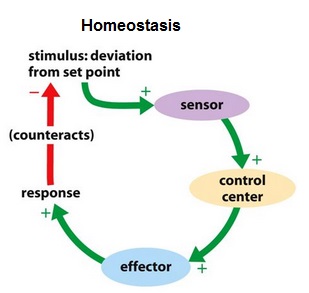 In the body of an animal conditions such as water concentration, temperature, and glucose concentration must be kept as constant as possible. Control systems that keep such conditions constant are examples of homeostasis; this is the maintenance of constant internal conditions in an organism.
In the body of an animal conditions such as water concentration, temperature, and glucose concentration must be kept as constant as possible. Control systems that keep such conditions constant are examples of homeostasis; this is the maintenance of constant internal conditions in an organism.
Some of the physiological factors controlled in homeostasis in mammals are:
- core body temperature
- metabolic wastes, particularly CO2 and urea
- blood pH
- blood glucose concentration
- water potential of the blood
- the concentrations in the blood of the respiratory gases, O2 and CO2.
The importance of homeostasis
The internal environment of an organism = conditions inside the body in which the cells function. A cell's immediate environment is the tissue fluid that surrounds it. Many features of the tissue fluid influence how well the cell functions.
- Temperature:
- low temperatures slow down metabolic reactions;
- at high temperatures proteins, including enzymes, are denatured and cannot function
- if the water potential decreases, water may move out of cells by osmosis, causing metabolic reactions in the cell to slow or stop;
- if the water potential increases, water may enter the cell causing it to swell and maybe burst
- Concentration of glucose
- glucose is the fuel for respiration, so lack of it causes respiration to slow or stop, depriving the cell of an energy source;
- too much glucose may cause water to move out of the cell by osmosis, again disturbing the metabolism of the cell.
In general, homeostatic mechanisms work by controlling the composition of blood, which therefore controls the composition of tissue fluid.
Homeostatic control
Homeostatic control mechanisms have at least 3 interdependent components: receptor, control center, and effector.
- The receptor senses environmental stimuli (external/internal), sending the information through the nervous system to a control center in the brain or spinal cord. This sensory information is known as the input.
- The control center, generally the brain, signals an effector (muscles and glands) to respond to the stimuli (to carry out an action, which is called the output). These actions are sometimes called corrective actions as their effect is to correct (or reverse) the change.
Positive feedback enhances or accelerates output created by an activated stimulus (any change in a factor, such as a change in bloodtemperature or the water content of the blood).
Negative feedback mechanisms consist of reducing the output or activity of any organ or system back to its normal range of functioning (e.g. adjusting blood pressure, metabolism, and body temperature).
Homeostasis in mammals requires complex systems to maintain internal conditions near constant. The kidneys remove wastes from the blood and are the effectors for controlling the water potential of the blood. a) discuss the importance of homeostasis in mammals and explain the principles of homeostasis in terms of internal and external stimuli, receptors, central control, co-ordination systems, effectors (muscles and glands) b) define the term negative feedback and explain how it is involved in homeostatic mechanisms c) outline the roles of the nervous system and endocrine system in co-ordinating homeostatic mechanisms, including thermoregulation, osmoregulation and the control of blood glucose concentration d) describe the deamination of amino acids and outline the formation of urea in the urea cycle (biochemical detail of the urea cycle is not required) e) describe the gross structure of the kidney and the detailed structure of the nephron with its associated blood vessels using photomicrographs and electron micrographs f) describe how the processes of ultrafiltration and selective reabsorption are involved with the formation of urine in the nephron g) describe the roles of the hypothalamus, posterior pituitary, ADH and collecting ducts in osmoregulation h) explain how the blood glucose concentration is regulated by negative feedback control mechanisms, with reference to insulin and glucagon i) outline the role of cyclic AMP as a second messenger with reference to the stimulation of liver cells by adrenaline and glucagon j) describe the three main stages of cell signalling in the control of blood glucose by adrenaline as follows: • hormone-receptor interaction at the cell surface • formation of cyclic AMP which binds to kinase proteins • an enzyme cascade involving activation of enzymes by phosphorylation to amplify the signal k) explain the principles of operation of dip sticks containing glucose oxidase and peroxidase enzymes, and biosensors that can be used for quantitative measurements of glucose in blood and urine l) explain how urine analysis is used in diagnosis with reference to glucose, protein and ketones |




Thank you for the good notes made with great efforts. Could you please upload notes for inherited changes, selection, biodiversity and gene technology
ReplyDeleteplease fix bugs in video links
ReplyDelete